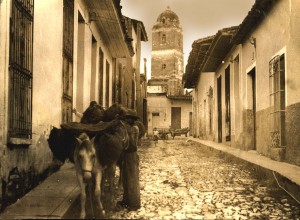 The ancient Cuban village readies to celebrate its 500th anniversary.“This is awful”, said Aurora Valdivia standing in front of the huge digger which, since the end of last February, began to pull up the floor of Serafin Sanchez Park, and to remove the trees, thus causing different reactions among locals used to have consensus on issues.
The ancient Cuban village readies to celebrate its 500th anniversary.“This is awful”, said Aurora Valdivia standing in front of the huge digger which, since the end of last February, began to pull up the floor of Serafin Sanchez Park, and to remove the trees, thus causing different reactions among locals used to have consensus on issues.
However, the renovation of the park is not only the most ambitious action of the building program designed to celebrate the half-millennium of the village next June 4th. It’s been also sort of shaking that has awakened local residents from the lethargy they seemed to be used to.
“The idiosyncrasy of Sancti Spiritus people is the result of their 500-year history, the events that led their ways, and mainly, the economic activity that predominated in the region: cattle raising”, has explained on more than one occasion María Antonieta Jiménez Margolles, historian of the city, in order to justify the apparent abulia present over here.
Her opinion is shared by Juan Eduardo Bernal Echemendía, president of Jose Marti Cultural Society in the province. He has for a long time studied aspects of local identity, partly because he’s worked as cultural promoter before, and partly because his family is closely related with the origin of local traditional (trova) music.
“Livestock production methods influenced the further development of the arts in here; there was plenty of singing music, but lack of plays or dancing —said Bernal Echemendía—; this phenomenon also explains the continuity of farmers’ legacy even on the most contemporary cultural expressions”.
That is why some people have termed rural a city that became the capital of the province, after the political-administrative division carried out back in 1976. On the other hand, there is still the influence of the nearby city of Santa Clara, which covertly refuses to give up its jurisdictional supremacy in the center of the island.
Translated into popular slang, all of these mean that the so-called fourth village can sometimes become traditional and conservative, two qualifiers that the sons of this land accept with a bit of resignation. “It is the attribute of locals, not to think bigger”, said Aurora Valdivia while referring to the long list of traditions which are about to disappear.
Among those traditions, the Santiago Espirituano stands out. It is sort of very peculiar carnival celebration, by no means similar to others in the island. Unfortunately, due to the shortage of budget and the lack of vision, this festivity is not in its glory days.
At least, this is the way nostalgic people like Agustín Cancio feel. He recalls the times in which he spent the nights dancing conga in the streets, or attending the endless rehearsals prior to the carnival season. Others in their early 30s, leave aside the romanticism of their elders and enjoy the new kind of fiesta that has necessarily adapted to current times.
Mediterranean and not precisely cosmopolitan Sancti Spiritus, “the most medieval of our first villages”, as it was once called by heritage expert Alicia García Santana, has so much accommodated itself to its lethargy, that it didn’t bother to raise its voice to stop the city of Camaguey from celebrating its 500th anniversary in February, 2014, instead of one year later, as it has been agreed upon by most Cuban historians.
But regardless of such cosmetic dilemmas, Sancti Spiritus residents are currently involved in a wide program to celebrate the village’s half-millennium anniversary. Moreover, they are certain of the value of their own culture, of the peculiar idiosyncrasy they have been shaping under the shadow of the Mayor Church, and the monumental bridge over Yayabo River.
(Taken from the blog Cuba Profunda, and translated by Escambray)
 Escambray ENGLISH EDITION
Escambray ENGLISH EDITION





Escambray reserves the right to publish comments.